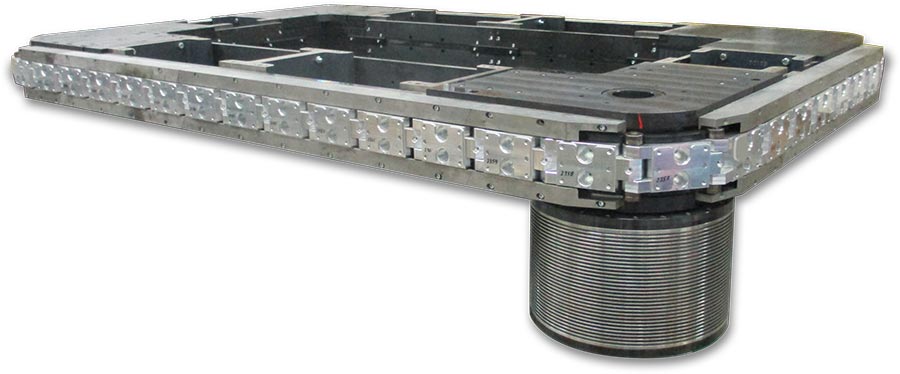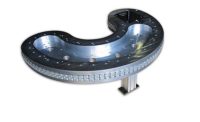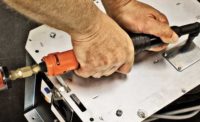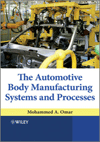In the rapidly evolving field of automotive manufacturing, the judicious implementation of precision indexing conveyors holds the potential to revolutionize assembly processes by optimizing efficiency, precision, and consistency. This technical guide delves into the intricacies of successfully integrating a precision indexing conveyor system, emphasizing key considerations for engineering excellence.
Assess Process Quantity and Sequencing: Begin by detailing each step of your production sequence that will take place on the conveyor. Ascertain the number of processes, their sequence, and interdependencies. This will determine the required stations of the indexing conveyor, their arrangement, and ultimately the overall length. It is suggested to determine the desired stroke you would like to move from station to station and select from a standard link size. Custom-sized links will increase the cost and delivery times. Standard link sizes can be stroked in increments of 1, 2, 3, and 4 at a time with a fixed cam indexer providing the positioning. Servo systems will offer more flexibility.
Determine Part Queue and Spacing Requirements: Calculate the buffer necessary between processes. This involves understanding the physical size of parts, the safety requirements, and the handling mechanisms in place. Adequate spacing ensures smooth transitions and minimizes bottlenecks, contributing to the optimization of cycle times.
Configure Conveyor Speed and Transition Timing: Define the conveyor's transition speed between processes to match your cycle time goals. The speed must be synchronized with the operational tempo of adjacent processes to maintain a harmonious production flow, avoiding both lags and forced waits.
Specify Positional Accuracy and Repeatability: The precision indexing conveyor must offer the positional accuracy and repeatability that aligns with the tolerances of your automotive components. Precision indexing conveyors provide superior accuracy compared to timing belt conveyors, for instance, so ascertain the level of precision required for each process and select a conveyor that meets or exceeds these specifications. The Motion Index Drives LFA series of precision indexing conveyors has a standard overall accuracy of +/- 0.0025” on the opposite end of the drive side. The cam followers that are assembled to the links of the LFA precision indexing conveyor are trapped on all sides by a hardened and ground rail system, providing high accuracy in x, y, and z positions.
Choose Between Programmable or Fixed Indexing: Decide if your system requires a fully programmable conveyor to accommodate various parts and processes, or if a fixed indexing stroke suffices. For dynamic production lines, a programmable conveyor provides flexibility, while a fixed system may offer simplicity and robustness for dedicated, unchanging tasks.
Environment Compatibility Assessment: Evaluate the environmental conditions of your facility. If operating in a cleanroom, for instance, the conveyor will need to comply with stringent particulate and contamination control standards. Each environment, whether cleanroom, foundry, or standard shop floor, imposes unique requirements on the conveyor system, from materials used to maintenance protocols.

Guidance for Implementation:
- Mapping the Processes: Create a flowchart of all assembly tasks to visualize the sequencing and interaction of each process on the conveyor. This will help identify any potential inefficiencies or conflicts in the production flow.
- Spacing Strategy: Develop a layout plan that includes the spatial arrangement of each station, factoring in the necessary buffer space for parts in the queue. Employ simulation software, if available, to model and optimize the spacing and flow.
- Speed Synchronization: Use time-motion studies to match conveyor speed with process times, ensuring a smooth cadence. Programmable Logic Controllers (PLCs) can help fine-tune the transition timing between stations.
- Precision Engineering: Select a precision indexing conveyor with the accuracy required for your application. Specify the absolute accuracy that is required at the most critical process.
- Flexibility vs. Consistency: Weigh the pros and cons of a programmable versus fixed conveyor system. Consider future-proofing your line with a programmable system if product variations or process changes are anticipated. The Motion Index Drives LFA systems can easily be converted from a fixed to a fully programmable unit, or vice versa.
- Robotics Integration: If auxiliary axes are necessary, collaborate with robotics engineers to design a coordinated control system that integrates the conveyor with robots that are on the line or other automated tools.
- Environmental Considerations: Ensure the materials and construction of the precision indexing conveyor are suitable for your operation's environment. Implement necessary modifications or protective measures to meet environmental standards.
- Testing and Validation: Prior to full-scale implementation, rigorously test the conveyor within the intended operational environment to validate performance against your process requirements. Each Motion Index Drives LFA system goes through a 24-hour accuracy test to ensure each unit is meeting or exceeding the customers’ requirements for accuracy and repeatability.

Through meticulous planning, precise engineering, and thorough validation, a precision indexing conveyor can be seamlessly integrated into an automated production line, resulting in a sophisticated system capable of meeting the high standards of modern automotive manufacturing.
 Ben Talan
Ben Talan
President
Motion Index Drives
(877) 978-1830
info@mid.us.com






